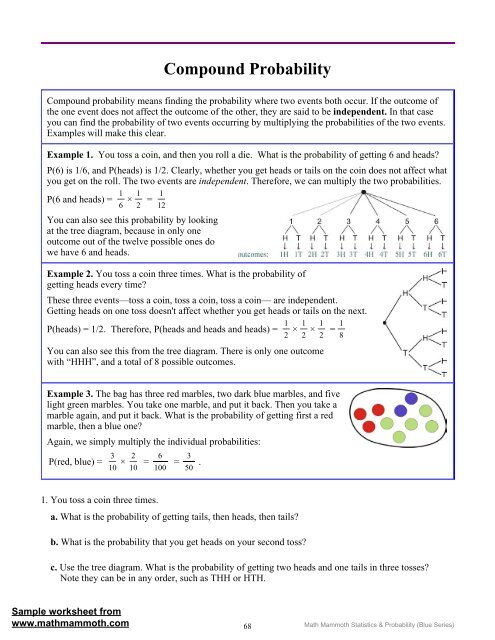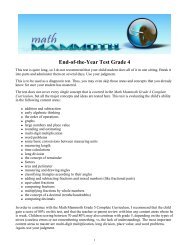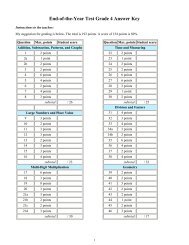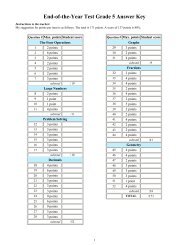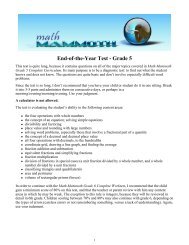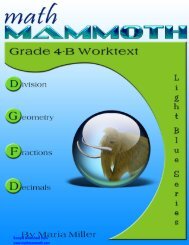Compound Probability - Math Mammoth
Compound Probability - Math Mammoth
Compound Probability - Math Mammoth
You also want an ePaper? Increase the reach of your titles
YUMPU automatically turns print PDFs into web optimized ePapers that Google loves.
1. You toss a coin three times.<br />
<strong>Compound</strong> <strong>Probability</strong><br />
<strong>Compound</strong> probability means finding the probability where two events both occur. If the outcome of<br />
the one event does not affect the outcome of the other, they are said to be independent. In that case<br />
you can find the probability of two events occurring by multiplying the probabilities of the two events.<br />
Examples will make this clear.<br />
Example 1. You toss a coin, and then you roll a die. What is the probability of getting 6 and heads?<br />
P(6) is 1/6, and P(heads) is 1/2. Clearly, whether you get heads or tails on the coin does not affect what<br />
you get on the roll. The two events are independent. Therefore, we can multiply the two probabilities.<br />
P(6 and heads) = 1<br />
6<br />
× 1<br />
2<br />
= 1<br />
12<br />
You can also see this probability by looking<br />
at the tree diagram, because in only one<br />
outcome out of the twelve possible ones do<br />
we have 6 and heads.<br />
Example 2. You toss a coin three times. What is the probability of<br />
getting heads every time?<br />
These three events—toss a coin, toss a coin, toss a coin— are independent.<br />
Getting heads on one toss doesn't affect whether you get heads or tails on the next.<br />
P(heads) = 1/2. Therefore, P(heads and heads and heads) = 1<br />
2<br />
You can also see this from the tree diagram. There is only one outcome<br />
with “HHH”, and a total of 8 possible outcomes.<br />
a. What is the probability of getting tails, then heads, then tails?<br />
b. What is the probability that you get heads on your second toss?<br />
c. Use the tree diagram. What is the probability of getting two heads and one tails in three tosses?<br />
Note they can be in any order, such as THH or HTH.<br />
× 1<br />
2<br />
× 1<br />
2<br />
Example 3. The bag has three red marbles, two dark blue marbles, and five<br />
light green marbles. You take one marble, and put it back. Then you take a<br />
marble again, and put it back. What is the probability of getting first a red<br />
marble, then a blue one?<br />
Again, we simply multiply the individual probabilities:<br />
P(red, blue) = 3 2<br />
×<br />
10 10<br />
Sample worksheet from<br />
www.mathmammoth.com<br />
= 6<br />
100<br />
= 3<br />
50 .<br />
68<br />
= 1<br />
8<br />
<strong>Math</strong> <strong>Mammoth</strong> Statistics & <strong>Probability</strong> (Blue Series)
2. You take a marble out of the bag and put it back. Then you take<br />
another marble. Find the probabilities.<br />
a. P(red, then green)<br />
b. P(green, then red)<br />
c. P(not blue, not blue)<br />
d. P(not red, not red)<br />
3. You roll a six-sided die two times. Find the probabilities.<br />
a. P(1; 5) b. P(even; odd)<br />
c. P(2; 5 or 6) d. P(6; not 6)<br />
4. The spinner is spun two times. Find the probabilities.<br />
a. P(blue; blue)<br />
b. P(green; not green)<br />
c. P(not blue; yellow)<br />
d. P(yellow or green; red or blue)<br />
5. The weatherman says that the chance of rain is 20% for each of the next five days, and your birthday<br />
is in two days! You also know that the probability of your dad taking you to the amusement park on<br />
your birthday is 1/2.<br />
a. What is the probability that you get to go the park, and it doesn't rain?<br />
b. What is the probability that you get to go the park, and it rains?<br />
Check: The sum of the probabilities in (a) and (b) should be 1/2.<br />
6. The two spinners are spun. The first spinner has eight regions<br />
and the second spinner has four. Find the probabilities:<br />
a. P(red, red)<br />
b. P(blue, not blue)<br />
c. P(yellow or green, yellow or green)<br />
d. P(not red, red)<br />
Sample worksheet from<br />
www.mathmammoth.com<br />
69<br />
<strong>Math</strong> <strong>Mammoth</strong> Statistics & <strong>Probability</strong> (Blue Series)


